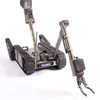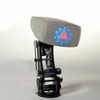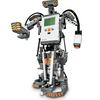Accuray Boeing Colin Angle Consumer Robotics CyberKnife CytoCare DARPA Education Financial Results Health Robotics Healthcare Robotics i.v.Station Industrial Robotics Industrial robotics International Space Station iRobot Liquid Robotics Lockheed Martin Medical Device Medical Robotics Medical robotics medical robotics Military Robotics Military robotics NASA Northrop Grumman Oceanography PackBot Remotely Operated Vehicle Research Robot Robotics ROV Schilling Robotics UAV Unmanned Aerial Vehicle unmanned aerial vehicle Unmanned aerial vehicle Unmanned Underwater Vehicle UUV
Fly Eye Inspires Vision System
November 13, 2009A recent Wired article described the work that researchers are doing whereby they are turning the brain cell activity that enables a fly's eyesight into mathematical equations in order to someday program vision systems for a wide variety of robotic applications
Apparently, however, the scientists who built the system don't have a firm grip on how it all works.
The article quotes David O'Carroll, a computational neuroscientist who studies insect vision at Australia's University of Adelaide, "We can build a system that works perfectly well, inspired by biology, without having a complete understanding of how the components interact. It's a non-linear system."
Ultimately, success would enable future generations of battle drones, search and rescue robots, and automobile navigation systems. For a more thorough understanding of the principles involved in the project, check out the article.
Are Shape Shifting Robots on the Horizon?
November 13, 2009Last week, Computerworld featured a piece on shape shifting robots that are getting ever closer to reality.
According to the article, researchers at both Intel and Carnegie Mellon University are utilizing large swarms of millimeter size robots and -- through the application of electromagnetic forces -- are enabling them to form up into various shapes and sizes.
As described in the article:
"the programmable matter is called claytronics and the tiny robots are called catoms. Each catom will have its own processor. Think of each catom as a tiny robot or computer that has computational power, memory and the ability to store and share power."
The technology marks a continuation of Seth Goldstein's research to create "programmable matter." Goldstein, an associate professor at Carnegie Mellon University, has been working with a team of scientists at Intel and the U.S. Air Force Research Lab on just such a feat for over two years.
Raven Unmanned Aircraft System Gets Nod from Dutch Military Aviation Authority
November 6, 2009AeroVironment, Inc. announced that the Military Aviation Authority of the Netherlands (MLA-NLD) has issued a Military Type Certificate (MTC) for the company's Raven B NLD MUAS, a move which will allow the Dutch military to operate Raven systems in designated Dutch airspace.
This is the first such certificate issued in the Netherlands in the Micro-Unmanned Aerial Vehicle category.
According to published reports, the Dutch selected the Raven B system following an open competition in 2007. Key elements resulting in its selection were hand-launchability, reliability, ease of use, robustness, and demonstrated in-theater operational performance and logistics support.
"Receiving this MTC validates the Raven system's airworthiness and reliability, but also represents an important step toward the operation of small UAS in our national airspace," said Dick Goedhart, head section type management unmanned aircraft, for the Netherlands Defence Ministry's Defence Materiel Organization or DMO
The Raven is a 4.2-pound, backpackable, hand-launched sensor platform that provides day and night, real-time video imagery for "over the hill" and "around the corner" reconnaissance, surveillance and target acquisition in support of tactical units.
Wilson's Robopocalypse Optioned to Dreamworks & Doubleday
November 6, 2009DreamWorks Studios and Doubleday announced they have acquired the rights to, "Robopocalypse," Daniel H. Wilson's unpublished manuscript that explores the fate of the human race following a robot uprising.
A 2011 date has been tentatively agreed upon as the launch date for the novel, and it has been reported that Dreamworks is putting the project into "accelerated development."
Wilson expressed his gratitude to the fans and well wishers who congratulated him on his success.
"Thanks to everybody for the congrats," he Tweeted. "Now I just hafta finish writing the novel. I *was* wondering what to do for the next year and a half."
Wilson's previous works include 2005's "How to Survive a Robot Uprising: Tips on Defending Yourself Against the Coming Rebellion;" "Where's My Jetpack?: A Guide to the Amazing Science Fiction Future That Never Arrived;" "How To Build a Robot Army: Tips on Defending Planet Earth Against Aliens, Ninjas, and Zombies;" and "The Mad Scientist Hall of Fame: Muwahahaha!"
He has a Ph.D.
ABI Sees Quadrupling Personal Robot Market by 2015
November 5, 2009ABI Research has released a new study predicting that the personal robotics market will achieve a global value of $1.16 billion this year, and that the market will more than quadruple by 2015, when worldwide shipments should approach $5.26 billion.
According to the report, Personal Robotics 2009: Task, Security & Surveillance/Telepresence, Entertainment and Education Robot, and Robotic Components Markets Through 2015:
Advances in military and commercial robots will continue to trickle down to the consumer market, and components will see price declines driven by their use in other markets (e.g., laser rangefinders in the automotive industry).
ABI Researchers consider the personal robotics market is made up of consumer products that have some intelligence, interface with their environment through sensors, and perform a desired function. These functions might include acting as a security system, or utility in the entertainment or educational spheres.
The research yields that North America is the largest market for personal robots, ahead of Asia-Pacific where Japan makes up a significant portion of the market. Western Europe is expected to grow into a significant market, but according to the report, Europeans are interested less in the cachet of owning a robot, and more in how well the robot performs its task.
Novint Adds Tactile Feedback for PackBot Operators
November 5, 2009Novint Technologies, Inc. has been awarded a subcontract with iRobot Corp. for a military robotics project funded by the Secretary of Defense Joint Ground Robotics Enterprise through the Robotics Technology Consortium (RTC).
The arrangement calls for Novint to co-develop a Remote Touch Kit (RTK) for iRobot's PackBot line of military-grade unmanned ground vehicles. Thre goal is to provide soldier operators the ability to experience force and tactile sensing when operating the PackBot from a distance.
According to a press release announcing the subcontract, the RTK will allow soldiers to feel how hard the PackBot's "gripper" squeezes an object, safely pick up and handle fragile objects, and feel when the robot's arm touches a wire or reaches a movement limit.
Universal Robotics, Motoman Team Up On 3D Vision Systems
November 5, 2009A partnership between Universal Robotics, Inc. and Motoman, Inc. will yield an accurate, cost effective and easy-to-implement 3D vision system solution for a variety of robotic applications. The idea is to integrate Universal's Spatial Vision self-calibrating 3D vision software in Motoman's industrial robots. It is hoped that the resulting solutions will be introduced to the materials handling market in early 2010.
Roger Christian, Vice President Marketing and International Groups at Motoman is excited at the prospect of the partnership. "The Spatial Vision software is an exciting breakthrough by Universal that will allow us to set a new price-performance point in the robotic 3D vision systems market.
Augusta Systems EdgeFrontier Powers NAVAIR Autonomous Swarm
October 31, 2009The U.S. Naval Air Systems Command (NAVAIR) announced a successful demonstration of autonomous operations by multiple "swarms" of unmanned air and ground vehicles, unattended ground sensors, video cameras and other devices linked together in an intelligent network powered by EdgeFrontier platform technologies from Augusta Systems, Inc.
The U.S. Department of Defense Unmanned Systems Roadmap 2009-2034 requires advances in autonomous operations, intelligent field-level processing, multi-vehicle common operational control and net-centric connectivity between unmanned systems and other surveillance assets, similar to the functionality demonstrated through the NAVAIR program relying on Augusta Systems EdgeFrontier.
EdgeFrontier products enable integration and normalization of data, events and control functions from diverse systems, as well as event processing and event and policy-based actions through a policy engine. For the demonstration, these capabilities resulted in a diverse, distributed, interoperable, intelligent network.
Volkswagen, Stanford U to Expand Cooperation
October 31, 2009According to press reports, Volkswagen Group and Stanford University plan to inaugurate the new Volkswagen Automotive Innovation Lab (VAIL) on the Stanford University campus at a dedication ceremony on October 31.
VW and Stanford are not by any means strangers. The two organizations have collaborated on several projects that have resulted in autonomous vehicles that have won the coveted DARPA Grand Challenge and Urban Challenge race series.
The expanded cooperation will see the two groups focus on innovative technologies in a bid to improve mobility, vehicle safety and environmental protection.
Said Volkswagen's Head of Group Research, Prof. Dr. Jürgen Leohold, "Stanford University and Volkswagen are ideal partners. VAIL is an important step in further developing this international collaboration. Both Science and industry should benefit equally from the new VAIL lab in paving the way toward new technologies."
The center, which is still under construction, will provide about 750 square meters of space for research teams from the fields of mechanical engineering, electronics and information technology, as well as a fully equipped workshop area.
MIT, VW Group Team on AIDA
October 31, 2009A collaborative effort between the Personal Robots Group at the MIT Media Lab, MIT's SENSEable City Lab and the Volkswagen Group of America's Electronics Research Lab is set to yield the Affective Intelligent Driving Agent (AIDA)
AIDA is an in-car personal robot that is designed to alter the way drivers interact with their vehicles.
Professor Carlo Ratti, director of the SENSEable City Lab, commented, "In developing AIDA we asked ourselves how we could design a system that would offer the same kind of guidance as an informed and friendly companion."
Professor Cynthia Breazeal, director of the Personal Robots Group at the MIT Media Lab explained, "We are developing AIDA to read the driver's mood from facial expression and other cues and respond in a socially appropriate and informative way."
Over time, researchers believe that a symbiotic relationship will develop between the driver and AIDA, whereby both parties continually learn from one other and establish a strong bond.
According to an official statement:
To identify the set of goals the driver would like to achieve, AIDA analyzes the driver's mobility patterns, keeping track of common routes and destinations. AIDA draws on an understanding of the city beyond what can be seen through the windshield, incorporating real-time event information and knowledge of environmental conditions, as well as commercial activity, tourist attractions, and residential areas.
"When it merges knowledge about the city with an understanding of the driver's priorities and needs, AIDA can make important inferences," said Assaf Biderman, associate director of the SENSEable City Lab. "Within a week AIDA will have figured out your home and work location. Soon afterwards the system will be able to direct you to your preferred grocery store, suggesting a route that avoids a street fair-induced traffic jam. On the way AIDA might recommend a stop to fill up your tank, upon noticing that you are getting low on gas," added Biderman.
Boston Dynamics Shows Off PETMAN
October 31, 2009Is it a pet? Is it a man? Is it an anthropomorphic robot designed for the purposes of testing chemical protection clothing to be used by US Army soldiers?
No. No. And why, yes!
PETMAN is the latest creation of Boston Dynamics, the company that has designed a number of innovative robots, including BigDog, a quadruped robot for travel on rough-terrain, RISE, a robot that climbs vertical surfaces, and SquishBot, a shape-changing chemical robot that moves through tight space, and many others.
It's a little creepy, but still a pretty neat proof of concept. Check out the YouTube video for yourselves.
PETMAN can balance itself and move freely; walking, crawling and doing a variety of suit-stressing calisthenics during exposure to chemical warfare agents.
Boston Dynamics says that PETMAN will also simulate human physiology within the protective suit by controlling temperature, humidity and sweating when necessary, in order to closely simulate realistic test conditions.
According to the Boston Dynamics site, the PETMAN development program has a 13 month design phase followed by a 17 month build, installation and validation phase, with delivery of the robot taking place in 2011.
iRobot Forms Healthcare Business Unit, Intros President
October 31, 2009iRobot Corp. chairman and CEO Colin Angle, will discuss the role of robots in the future of healthcare at the upcoming TEDMED conference in San Diego, Calif.
Angle will also use the opportunity to introduce Tod Loofbourrow as president of iRobot's newly-created healthcare business unit. According to the company, the new business unit will explore the potential role of robotics as an assistive technology to promote wellness and enhance quality of life for seniors.
"Hiring Tod to lead our new healthcare business unit underscores the significance of this market opportunity, as well as the commitment the company is making in this space," said Angle.
Last week, iRobot announced third quarter results.
National Instruments Updates LEGO Robotics Software
October 27, 2009National Instruments has developed a new version of its intuitive drag-and-drop software that powers the LEGO MINDSTORMS NXT 2.0 robotics kits. The software offers new features such as color recognition, Bluetooth support and additional robot models.
The software is based on the widely adopted NI LabVIEW graphical programming environment, and will be included with all LEGO MINDSTORMS NXT 2.0 kits.
"We are constantly amazed at how graphical programming based on LabVIEW makes the NXT simultaneously powerful and easy to use," said Lars Nyengaard, director of innovation and robotics for the LEGO Group. "We're proud to have built the MINDSTORMS software around LabVIEW technology, which uses picture-based interaction that facilitates a fun and creative design experience for children.
Health Robotics Deploys i.v.Station in Madrid Hospital
October 27, 2009Health Robotics hailed the recent unveiling of i.v.STATION at Gregorio Maranon University Hospital in Madrid. Juan Jose Guemes, Health Secretary of State for Madrid's Regional Government toured the hospital's pharmacy aseptic compounding facilities, and inspected how i.v.STATION automatically prepared IV medications from Spanish drug vials in a variety of syringe sizes.
Meeting with reporters, Guemes said, "i.v.STATION permits much more efficient use of the medications, especially for high-cost and high-risk medications, focusing on patients requiring strict therapy guidelines and rigorous pharmaco-vigilance and control of the aseptic compounding process."
Guemes also announced plans to roll out the technology throughout the rest of the public hospital system in the Madrid Region
According to Health Robotics, i.v.STATION represents a revolutionary approach in the quest for safe, accurate, efficient, cost effective, and ready-to-administer intravenous patient doses, offering reduction of medication errors, ISO-compliant accuracy, improved sterility, and clinician labor savings: all within a scalable, cost-effective, distributed, and fail-safe architecture.
Health Robotics Announces Shipments, Innovation Award Win
October 12, 2009Health Robotics has announced the manufacturing, shipment, and subsequent field installation of the first five i.v.STATION post-prototype robots in the United States of America and in Spain within the September to November timeframe this year.
"These first five shipments of i.v.STATION represent the culmination of extraordinary work by our engineers and beta test customers and, I hope, also the start of a new era for Health Robotics in bringing our robots and software automation solutions out of the pharmacy basement and into the nurse stations and satellite pharmacies, as close as we can get to the patients," stated Werner Rainer, Health Robotics' CEO. About Health Robotics, in a statement.
Health Robotics also announced its i.v.STATION robot had won the Area Science Park 3L 3T Innovation Award.
According to AREA Science Park, who bestows the honor, the 3L 3T Innovation Award recognizes the "best technology products conceived or launched in 2009, the results of sometimes lengthy and complex research and development work, aimed at bringing tangible innovations to the market in order to improve our working and personal lives."








